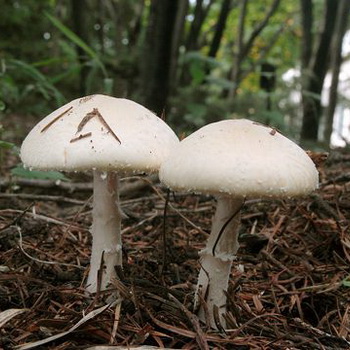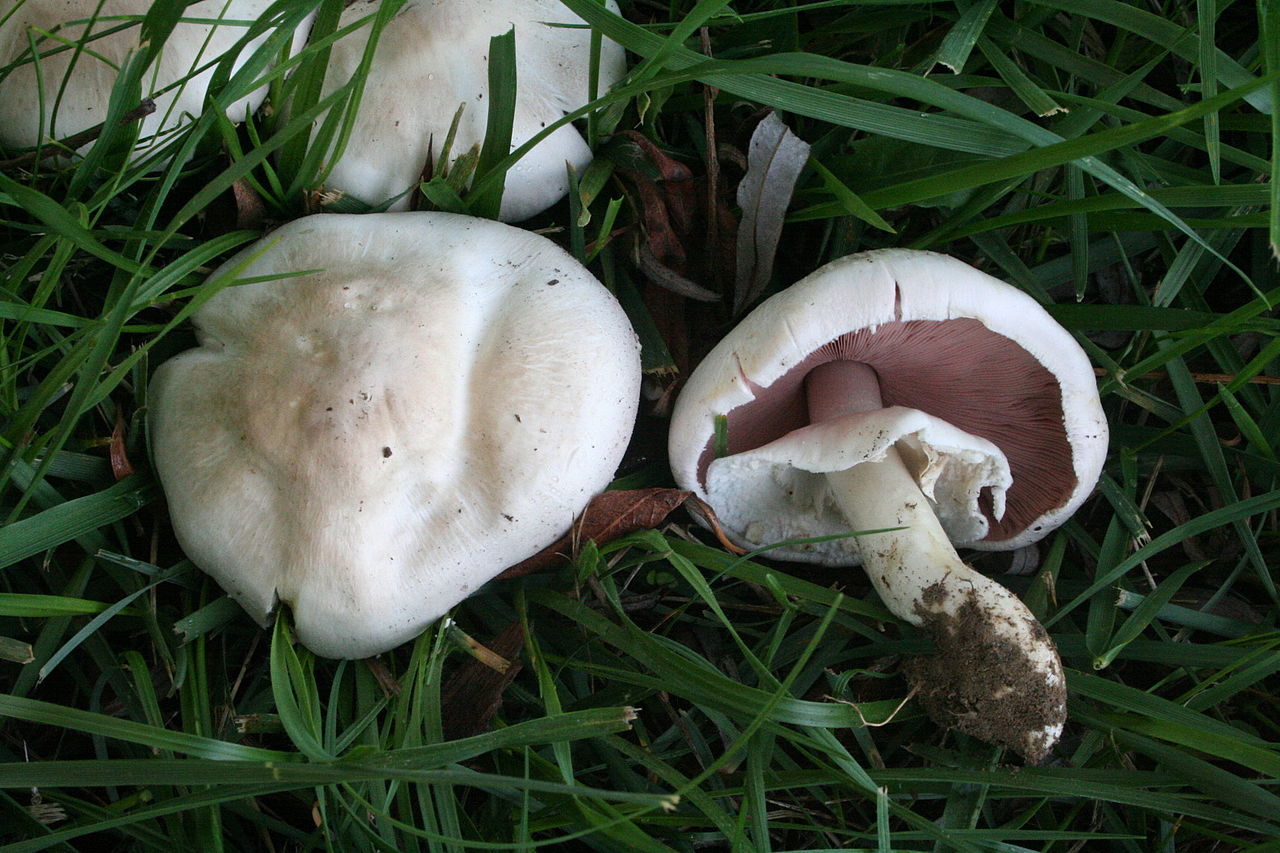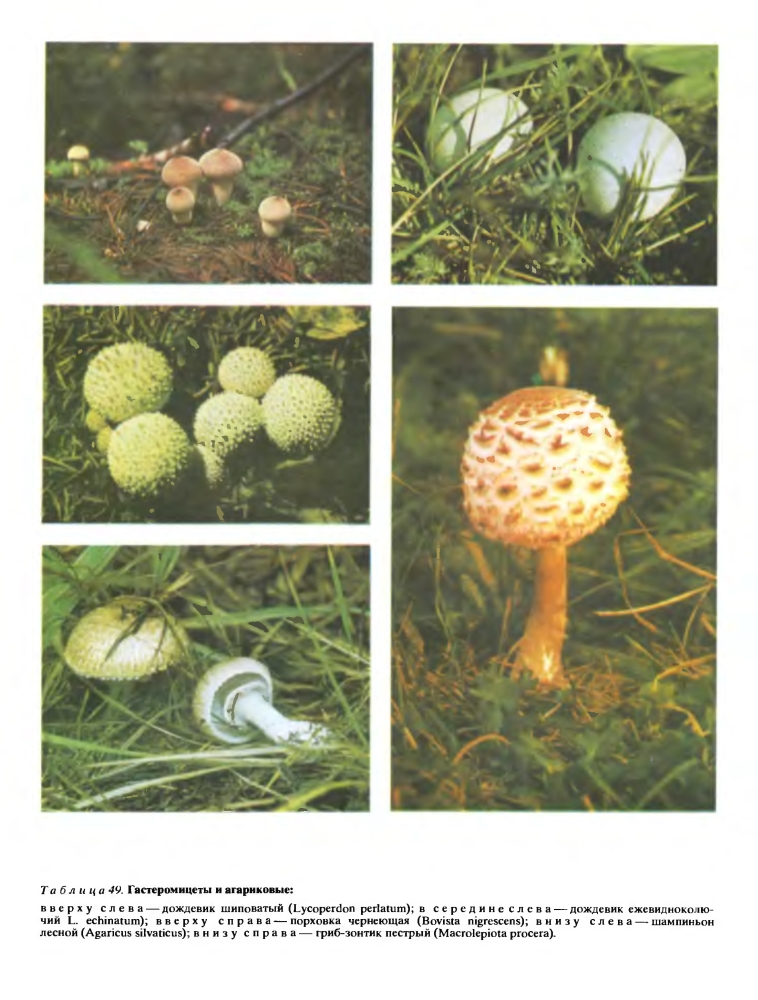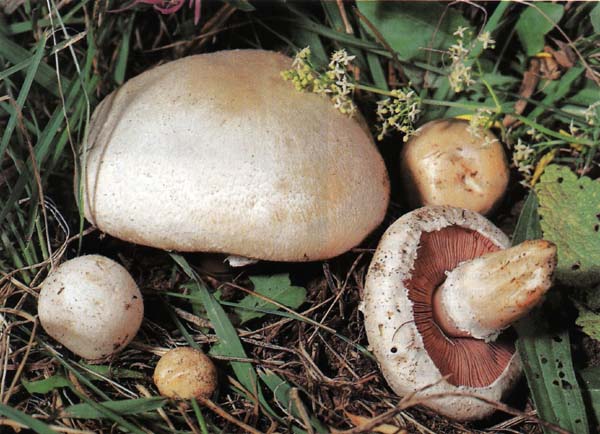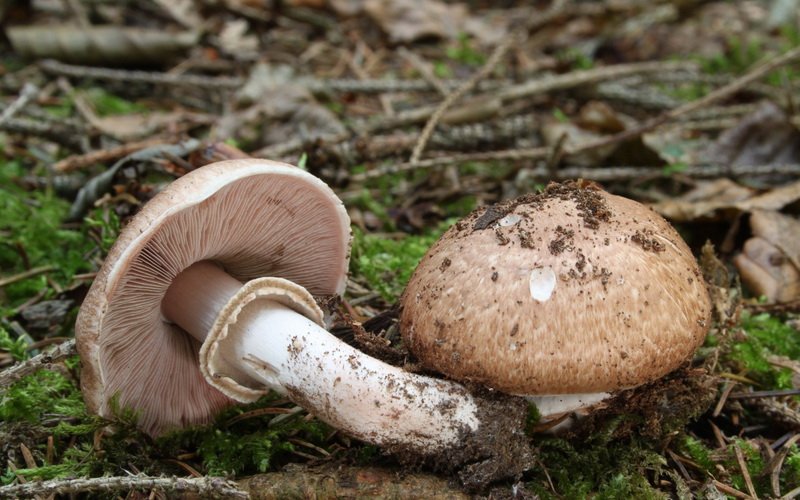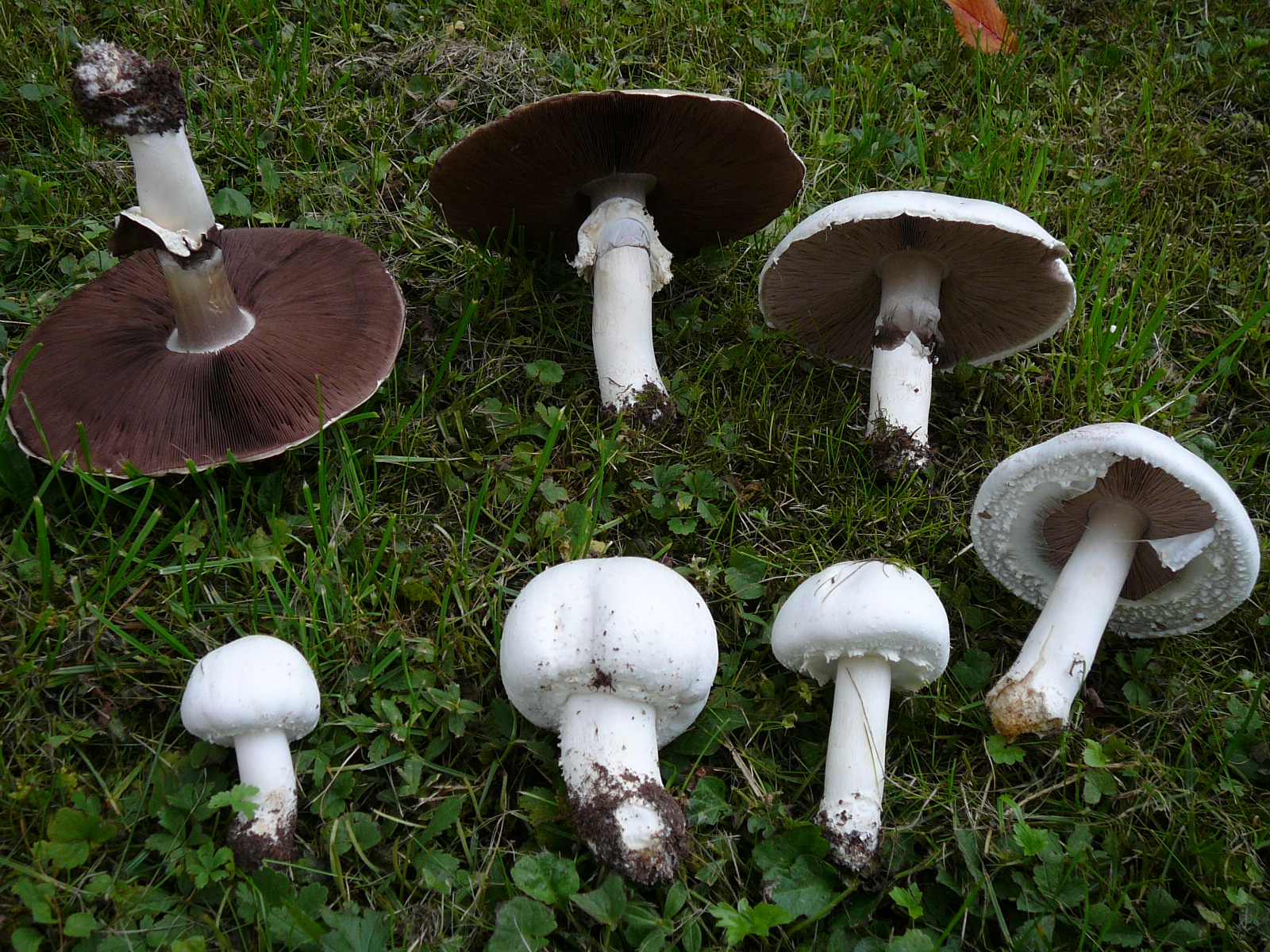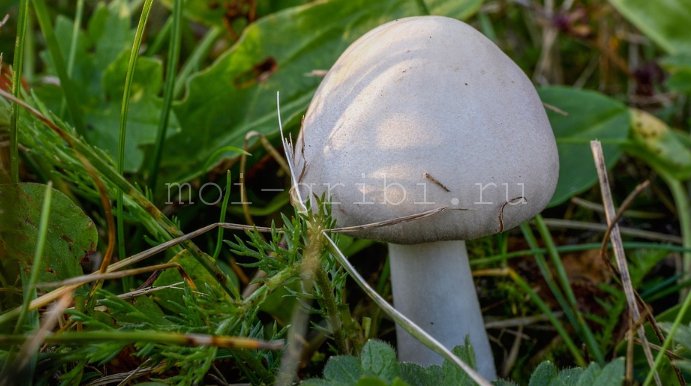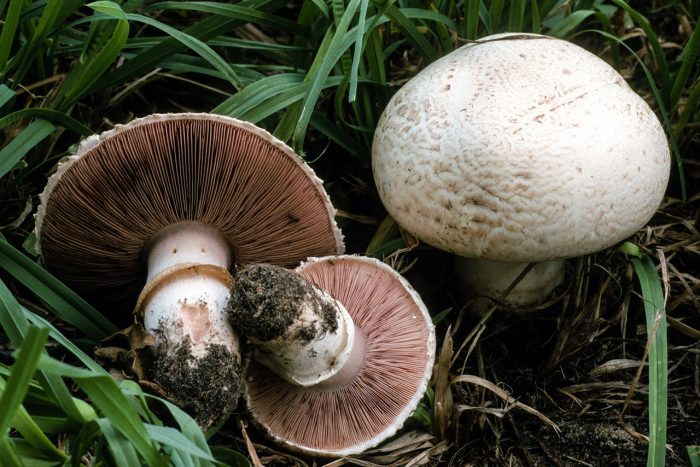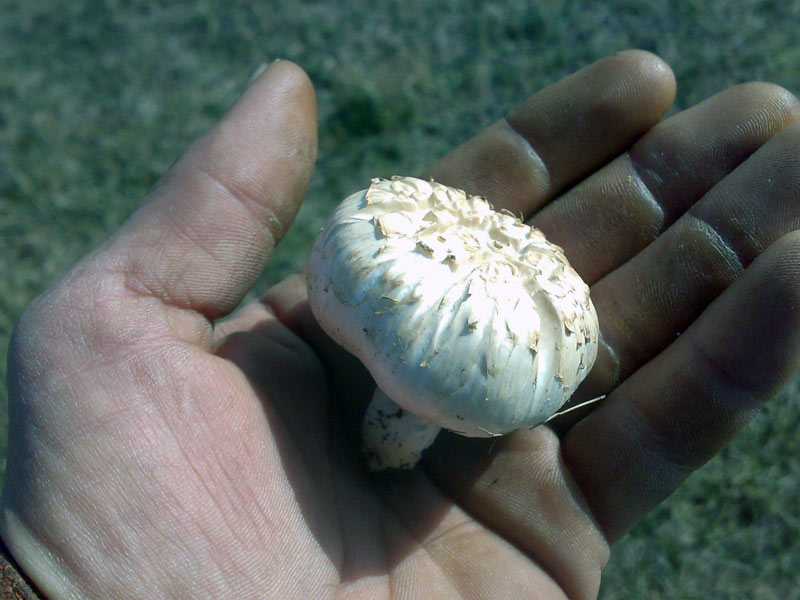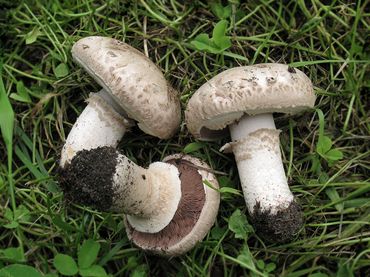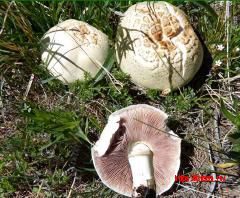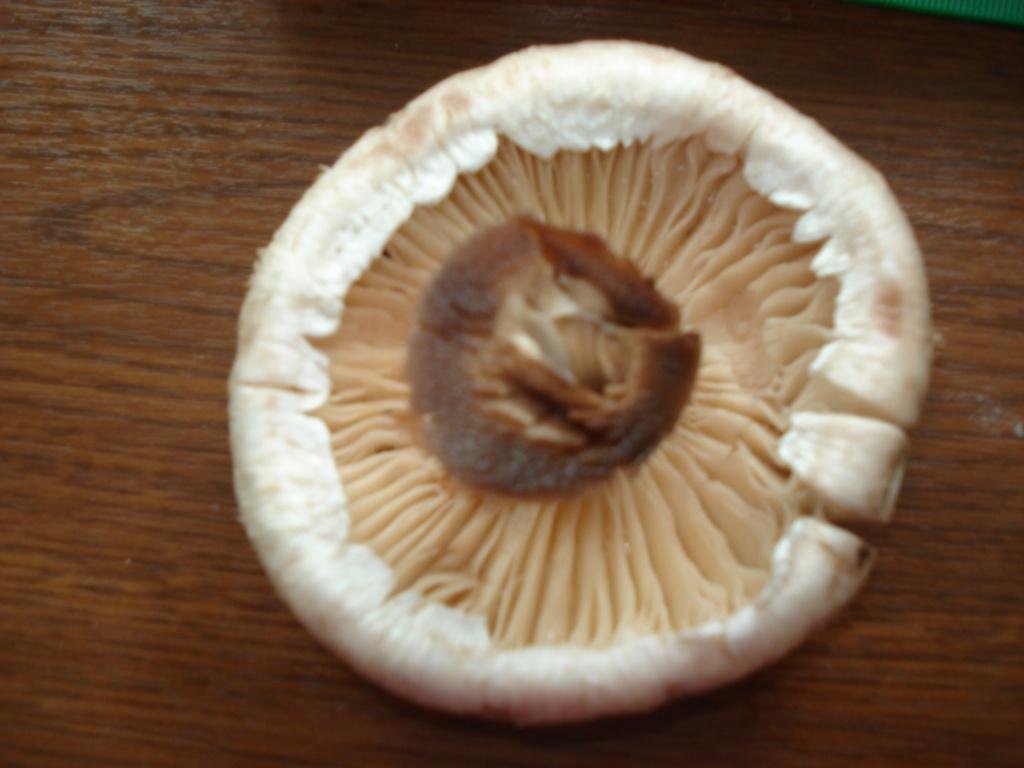Description
Hat
 Opening early, since the common veil breaks while the fruiting body is still underground. It has a convex shape, almost flat in old mushrooms.
Opening early, since the common veil breaks while the fruiting body is still underground. It has a convex shape, almost flat in old mushrooms.
The skin is dry, slightly rough to the touch, with sparse few scales near the center of the cap. The structure is dense, the old mushroom is loose, fleshy. The cap is colored from white to light brown. The edges of the cap are folded inward. In size it reaches from 6 to 12 cm. The skin is separated from the pulp with difficulty.
Spore-bearing layer
 Lamellar. It is initially painted white, but by the time the fruiting body appears on the surface, it is more often pink or light brown.
Lamellar. It is initially painted white, but by the time the fruiting body appears on the surface, it is more often pink or light brown.
The plates are often located, not adherent. By old age, the color changes to a deep brown. The spore powder is brown.
Leg
Reaches 10 cm in height and up to 4 cm in diameter. Dense, powerful, with firm flesh. There are two leathery rings on the leg. The leg is painted white, sometimes with a cream shade, color.
Pulp
With a weak mushroom aroma and a slightly pronounced pleasant sourish taste. At the site of a break or cut, it slowly changes color from white to pink.
Poisonous and inedible types of mushrooms
California champignon (Agaricus californicus)

The surface of the cap is dry, whitish or brown, dark in the center, glabrous or scaly. The edge of young mushrooms is folded down. The pulp has an unpleasant odor similar to phenol. The leg is smooth, curved, with a ring.
Grows in forests and gardens of California.
Möller's champignon (Agaricus moelleri)

The diameter of the cap is 5-14 cm, convex or flat, the surface is white, scaly. The pulp is white, it turns brown on the cut, the smell is unpleasant. The leg is 6-10 cm high, 1-1.5 cm thick, white, yellow in old mushrooms, the base is expanded.
It grows on fertile soil, in forests and parks, in groups and rings, in the northern temperate zone. Rare view. Fruiting is observed from late summer to autumn.
Dark-scaled champignon (Agaricus phaeolepidotus)

The cap is 5-8 cm in diameter, in young mushrooms it is hemispherical and bell-shaped, later convex and prostrate, white or brown, scaly. The leg is 4-8 cm high, 1-1.2 cm in diameter, flat or curved, thickens at the base, naked, fibrous, whitish, with a ring. The pulp is soft, white, turns yellow in the air. The smell is not pronounced.
Grows in Europe, in deciduous forests, in groups.
Champignon tabular (Agaricus tabularis)

Little known inedible mushroom.
The cap is flat-convex, 5-10 cm in diameter, thick, fleshy, dense, whitish, cracking and scaly. The flesh is whitish, turns yellow when touched. The leg is 1-3 cm in thickness, 3-4 cm in height, thick, wide, dense, with a ring.
Grows in deserts, semi-deserts, steppes of Eurasia, North America. The species is included in the Red Book of Ukraine.
Champignon yellow-skinned, or red (Agaricus xanthodermus)
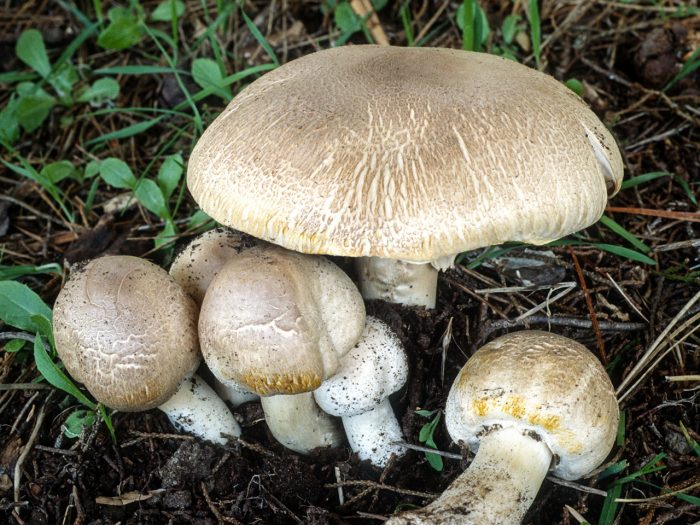
The diameter of the cap is 5-15 cm, the shape is bell-shaped, the edge is bent inward, fleshy, white, turns yellow when touched, the surface is smooth and dry. The pulp is brownish-white, yellow-orange at the base of the stem, has an unpleasant smell of phenol. Leg 6-10 cm high, 2-3 cm wide, white, hollow.
Found in deciduous forests in North America and Europe, Australia. Fruiting from July to October.
The most famous champignon is ordinary
We are all accustomed to buying the considered mushroom fruits in supermarkets or in the markets - white balls with edges curved to the leg, resemble a perfect ball and are pleasant to the touch. The light skin of the young representative resembles velvet. With age, the delicacy begins to open up and increases several times in size, the color darkens. This species grows on a very fertile substrate, most often it is soil rich in humus, or meadows naturally fertilized with the manure of herbivorous livestock.
The ripening period of the "ordinary" species is from the end of May to the end of October (November - for warm regions). The crop can be harvested several dozen times over the entire season.The mushroom tastes good and is used to prepare various dishes, from salads to complex sauces or baked goods.
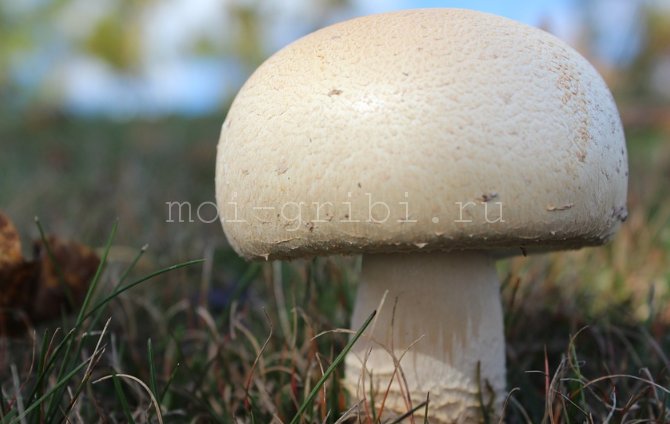
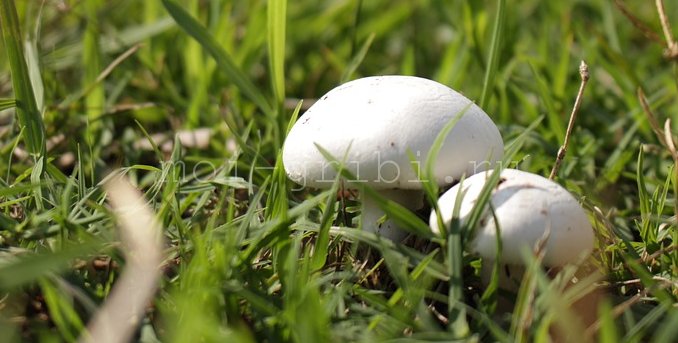
Here we will say a few words about the forest representative of the family. It resembles a bell on a high leg. The hat is covered with dark scales. Safe for humans.
Species table
| Name | From latin | Category |
|---|---|---|
| Elegant | Agaricus comtulus | good edible mushroom |
| Tabular | Agaricus tabularis | conditionally edible mushroom |
| Big forest | Agaricus mediofuscus | good edible mushroom |
| Carbolic | Agaricus placomyces Peck | inedible non-toxic mushroom |
| Crooked | Agaricus abruptibulbus | good edible mushroom |
| Field | Agaricus arvensis | good edible mushroom |
| Augustow | Agaricus augustus | good edible mushroom |
| Beneš | Agaricus benesii | good edible mushroom |
| Bernard | Agaricus bernardii | good edible mushroom |
| Cultivated | Agaricus bisporus | excellent edible mushroom |
| Two-ring | Agaricus bitorquis | good edible mushroom |
| Lugovoi | Agaricus campester | good edible mushroom |
| Dark red | Agaricus haemorrhoidarius | good edible mushroom |
| Large spore | Agaricus macrosporus | excellent edible mushroom |
| Motley | Agaricus meleagris | inedible non-toxic mushroom |
| Blushing | Agaricus semotus | conditionally edible mushroom |
| Forest | Agaricus silvaticus | good edible mushroom |
| Steam | Agaricus varoparius | good edible mushroom |
| Yellow-skinned | Agaricus xanthodermus | toxic mushroom |
| Redhead | Agaricus xanthodermus | toxic mushroom |
Poisonous types of champignons
Not all the fruits of the family we are considering can be eaten, so every potential gatherer should know how the poisonous mushrooms, beloved by everyone, look like
Pay attention to the description of dangerous mushrooms, as they are also often found in the wild:
Yellow-skinned (Agaricus xanthodermus)
It looks like a field fellow, only the leg is yellowish-orange. The damaged skin or pulp also acquires a yellow tint, exudes a nasty smell, reminiscent of carbolic acid.
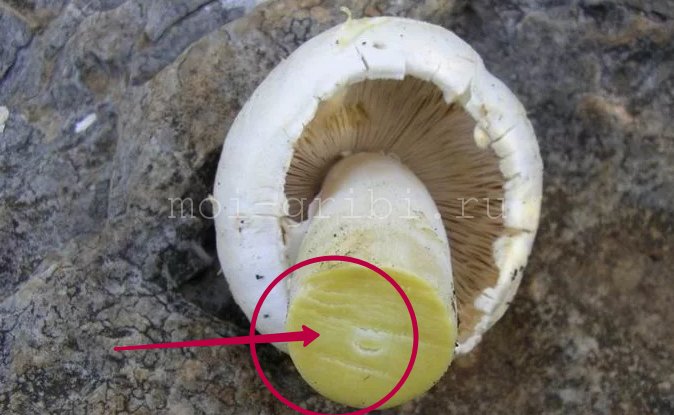
He's ginger
It has a medium-sized head, widening at the edges, the surface is covered with small scales. If you press on the pulp with your fingernail, it instantly turns yellow. The stem is thin, often empty inside, bordered by a small fibrous rim. On the inner side of the cap there are thin, frequent plates of light shades (can be beige or pink); during aging, the plates darken and become brown-brown. You can distinguish a mushroom from an edible one both visually and by its smell, which can hardly be called pleasant. It happened that people consumed several fruits of the red-colored champignon - there was no lethal outcome, but unpleasant poisoning could not be avoided.
Motley (Agaricus meleagris)
Other names are carbolic, flat, scaly. By the appearance of the fruit, it is easy to determine which mushroom is in front of you - a gray cap with a darkened core also exudes the smell of carbolic acid. Folk healers and experienced old women argue that this variety is suitable for eating if the deceptive forest gift is thermally processed at least five times, but it is better not to risk your own health.
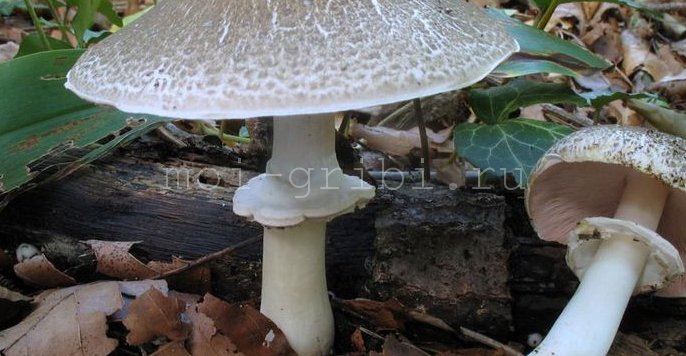
We have considered the most common types of champignons, since they are most often found by numerous gatherers. Do not be afraid to go for the forest harvest, improve your knowledge and remember the golden rule of any forester - “Doubt? Do not take".
Gerbera in a pot reviews
| Name: | Field champignon |
| Latin name: | Agaricus arvensis |
| Type of: | Edible |
| Synonyms: | Common champignon, sidewalk champignon |
| Specifications: |
|
| Systematics: |
|
Field champignon - one of the types of lamellar mushrooms, part of the Champignon family. He is the largest member of the genus. In some reference books, it can be found under the name common champignon or sidewalk. In official sources, it is designated as Agaricus arvensis.
Distribution and ecology
All champignons are saprotrophs, and grow mainly on manured soil, on organic-rich forest and meadow humus, they are found on the bark of dead trees and on anthills. By confinement to certain types of substrate of representatives of the genus Agaricus subdivided into 5 groups: growing only in forests (A. silvaticus, A. silvicola); soil saprotrophs of open non-vegetation spaces (A. bisporus, A. bitorquis, A. subperonatus); herbophiles growing only among the grass (A. campester, A. augustus and etc.); growing in open spaces among grass and forests (A. arvensis, A. comtulus and etc.); desert species, including halophytes (A. bernardii, A. tabularis).
The greatest species diversity of champignons is observed in the steppes and forest-steppes of Eurasia, in the prairies, pampas, in meadows and open spaces of Australia and Africa.
Two-ring champignon
| Group: | Lamellar |
|---|---|
| Plates: | Pink, light brown |
| Colour: | White to light brown |
| Info: | The pulp turns pink at the cut |
| Department: | Basidiomycota (Basidiomycetes) |
|---|---|
| Subdivision: | Agaricomycotina (Agaricomycetes) |
| Class: | Agaricomycetes (Agaricomycetes) |
| Subclass: | Agaricomycetidae |
| Order: | Agaricales (Agaric or Lamellar) |
| Family: | Agaricaceae (Champignon) |
| Genus: | Agaricus (Champignon) |
| View: | Agaricus bitorquis (Two-ring champignon) |
The edible mushroom belongs to the second food category. Another representative of the champignon family.
If many other species are quite similar to each other and can be easily confused, then two-ring champignon can be recognized almost instantly, as soon as you pick it up. The word "chunky" suits this champignon perfectly. Fat meat, on an uncharacteristically short leg and already with two rings on it.
This variety has one more advantage. This champignon can be found much more often practically in urban areas than in the forest. But it is worth remembering that champignons are a real sponge for heavy metals and other harmful derivatives of human life. Therefore, you need to be extremely careful when picking mushrooms in urban areas.
Hat
The skin is dry, slightly rough to the touch, with sparse few scales near the center of the cap. The structure is dense, the old mushroom is loose, fleshy. The cap is colored from white to light brown. The edges of the cap are folded inward. In size it reaches from 6 to 12 cm. The skin is separated from the pulp with difficulty.
Spore-bearing layer
The plates are often located, not adherent. By old age, the color changes to a deep brown. The spore powder is brown.
Leg
Reaches 10 cm in height and up to 4 cm in diameter. Dense, powerful, with firm flesh. There are two leathery rings on the leg. The leg is painted white, sometimes with a cream shade, color.
Pulp
With a weak mushroom aroma and a slightly pronounced pleasant sourish taste. At the site of a break or cut, it slowly changes color from white to pink.
Distribution and collection
The two-ring champignon is one of those mushrooms that prefer to settle near human habitation and are quite rare at any distance from it. This mushroom can easily be found along the edges of paths, in parks, gardens, pastures and pastures. It is found, as a rule, in groups of 3-7 specimens.
Similar species
From the dangerous double of all champignons, the two-ring champignon is distinguished by the absence of an egg-shaped depression at the base, a darker hymenophore, a powerful constitution and a double ring on the stem.
Almost all champignons that can be found in our latitudes are in one way or another similar to the two-ring champignon. It is quite easy to distinguish it from its fellows:
- First, the ratio of the length of the stem to the general constitution of the fungus is striking; it is disproportionately short.
- Secondly, no other mushroom species has a double ring anymore.
Use
The double-ring champignon does not require any pretreatment. It can be used both raw in a salad and fried, boiled, stewed. Champignons can also be harvested in salted or pickled form, but they are much tastier when fresh.
Interesting Facts
Two-ring champignon is an extremely strong mushroom. If the fruit body grows under the asphalt or even the pavement, it is capable of lifting and breaking through even such a powerful obstacle.
Due to the short legs, this type of champignon is not cultivated on an industrial scale, since this feature excludes the machine method of picking mushrooms.
Growing champignons at home

The main component of the mushroom growing medium is compost. This is a 1: 3 mixture of winter rye or wheat straw and horse manure. The substrate is prepared outdoors under a canopy or in a well-ventilated area.
Substrate ingredients: per 100 kg of straw, 2 kg of urea, 2 kg of superphosphate, 7-8 kg of gypsum, 5 kg of chalk. After adding manure, about 300 kg of substrate is obtained, which is enough for an area of 2.5-3 m².
First, the straw is soaked for a day. Moistened straw and manure are stacked in layers (3-4 of each layer). In the process of laying it, the straw layer is additionally moistened (300-400 liters of water are used per 100 kg of straw) and 0.5 kg of superphosphate and 2 kg of urea are gradually added. The mixture is thoroughly mixed and all other ingredients are added. Then the fermentation of the substrate begins, on the 3rd day the temperature inside the stack rises to 65-70 ° C. With a stack height of 1.5 m, a length and width of 1.2 m, the compost will be ready after 3 weeks.
High-quality, sterile mushroom mycelium is used as a seed. There are two types of it: grain and compost. For 1 m² and 100 kg of substrate, 350-400 g of grain mycelium are required. Compost consumes about 500 g, it is more stable, but less productive.
Before sowing, heat treatment or pasteurization of the substrate is carried out. After it is cooled to 24-25 ° C and covered with a layer of 25-30 cm in boxes. About 100 kg of substrate is used for 1 m² of area. A handful of mycelium is deepened by 4-5 cm, placing the holes in a checkerboard pattern at a distance of 20-25 cm.
Room humidity is maintained at 70-95%. The boxes are covered with burlap or newspaper and sprinkled gently with water. The optimum temperature inside the substrate is 20-27 ° C.
After 8-12 days, the mycelium will grow and the surface of the substrate is covered with a casing layer of 1 part of chalk and 9 parts of peat. 40-50 kg of cover soil is spent on 1 m² of area.
3-5 days after that, the room temperature is lowered to 12-17 ° C. The surface continues to be moistened, the room is well ventilated.
The first crop appears after 3-4 months. Collect champignons with a stretched film connecting the leg and the edge of the cap. The mushrooms are carefully twisted, and the holes are sprinkled with cover earth and watered.
Fruiting lasts 8-14 weeks and gives up to 7 harvest waves. 5-12 kg of mushrooms are harvested from 1 m² of area.
Where does the field champignon mushroom grow?
This species is found mainly in meadows, lawns, and gardens. Prefers open, well-lit places. It grows directly on the soil. It can also be found in light thickets of grass in parkland, clearings and roadsides. It grows both on plains and in mountainous areas.
Field champignon occurs singly, in small groups and whole mushroom families, forming semicircles and rings.
Field champignon does not like the neighborhood with trees, the only exceptions are spruce. Widely distributed in Europe and the Caucasus. On the territory of Russia, it is found in all regions.
How to cook field mushrooms
Pre-peeled mushrooms can be used fresh to prepare various salads and sauces. In this case, they must be slightly dried and cut into slices.
Also, field mushrooms can be heat treated, so you need to know how to cook them correctly so that they retain their taste.
How much to cook field mushrooms

This type must be boiled for 10 minutes. in salted water. After that, the mushrooms should be put in a colander and allowed to drain.
In this form, they can be used for making soups, main courses, and also as a filling for pies.
How to fry field mushrooms

To fry mushrooms, they must first be boiled and allowed to drain off the water. After that, the mushrooms must be cut into longitudinal plates.
In the meantime, heat a frying pan and pour in a small amount of sunflower oil. Then put the mushrooms, salt, pepper and fry for 5-7 minutes, remembering to stir constantly. If desired, sunflower oil can be replaced with butter.
How to prepare field mushrooms for the winter

It is recommended to dry and pickle field mushrooms as winter preparations. At the same time, the mushrooms retain their pleasant taste and aroma.
For drying, they must first be cleaned and cut into longitudinal plates. Washing is not required in this case. After that, the resulting slices are strung on a thread and hung in a dark dry room, covered with gauze from insects. After 2-3 days, put the mushrooms in a cloth bag for long-term storage.

For pickled field mushrooms for the winter, you will need:
- mushrooms - 2 kg;
- water - 0.5 l;
- salt - 30 g;
- sugar - 40-50 g;
- citric acid to taste;
- allspice - 7 pcs.;
- cloves - 8 pcs.
- Boil mushrooms with salt and citric acid.
- Strain, put in prepared jars.
- Prepare the marinade with the addition of all the remaining components, boil for 10 minutes.
- Pour cans, roll up.
Cover the containers with a warm blanket to cool slowly. After two days, put the cans in the basement.
Views
About 200 types of champignons are known.For a complete list, see Species of the genus Champignon
| Cat. * | Latin name | Russian name | ||||||||||
|---|---|---|---|---|---|---|---|---|---|---|---|---|
| Agaricus abruptibulbus | Champignon distinctly nodulating, white champignon, crooked champignon, cultivated champignon | |||||||||||
| Agaricus arorae | ||||||||||||
| Agaricus arvensis(Agaricus exquisitus)(Agaricus leucotrichus) | Field mushroom, sheep mushroom | |||||||||||
| Agaricus augustus(Agaricus perrarus) | Champignon august | |||||||||||
| Agaricus bambusae | ||||||||||||
| Agaricus benesii(Agaricus carolii)(Agaricus squamuliferus) | Champignon Beneša | |||||||||||
| Agaricus bernardii(Agaricus ingratus)(Agaricus maleolens) | Bernard's champignon, steppe champignon | |||||||||||
| Agaricus bisporus(Agaricus brunnescens)(Agaricus cookeanus)(Agaricus hortensis) | Champignon royal brown, garden champignon, double champignon, cultivated champignon, cultivated champignon | |||||||||||
| Agaricus bitorquis(Agaricus edulis)(Agaricus rodmani) | Two-ring champignon, sidewalk champignon | |||||||||||
| Agaricus californicus | ||||||||||||
| Agaricus campester(Agaricus campestris) | Common champignon, real champignon, meadow mushroom, pepper | |||||||||||
| Agaricus cupreobrunneus | ||||||||||||
| Agaricus excellens | ||||||||||||
| Agaricus devoniensis | ||||||||||||
| Agaricus dulcidulus(Agaricus purpurellus) | ||||||||||||
| Agaricus fuscofibrillosus | ||||||||||||
| Agaricus fuscovelatus | ||||||||||||
| Agaricus haemorrhoidarius | Champignon dark red | |||||||||||
| Agaricus hondensis | ||||||||||||
| Agaricus langei(Agaricus mediofuscus) | Champignon Lange, mushroom large forest | |||||||||||
| Agaricus lanipes | ||||||||||||
| Agaricus lilaceps | ||||||||||||
| Agaricus macrosporus | Large-spore champignon | |||||||||||
| Agaricus meleagris(Agaricus placomyces)(Agaricus moelleri)(Agaricus praeclaresquamosus) | Motley champignon, flat mushroom champignon, carbolic champignon, dark scaly champignon, scaly champignon | |||||||||||
| Agaricus pattersonae | ||||||||||||
| Agaricus phaeolepidotus | ||||||||||||
| Agaricus porphyrizon | ||||||||||||
| Agaricus rusiophyllus(Agaricus comtulus)(Agaricus niveolutescens) | Pink-plate champignon, graceful champignon | |||||||||||
| Agaricus semotus | Red champignon, reddish champignon | |||||||||||
| Agaricus silvaticus(Agaricus sanguinarius)(Agaricus vinosobrunneus) | Forest mushroom, blagushka | |||||||||||
| Agaricus silvicola(Agaricus flavescens) | Coarse champignon, thin champignon, whitish champignon, smooth champignon, smooth forest champignon | |||||||||||
| Agaricus spissicaulis | Mushroom chunky | |||||||||||
| Agaricus subperonatus | ||||||||||||
| Agaricus subrutilescens | ||||||||||||
| Agaricus tabularis | Champignon tabular | |||||||||||
| Agaricus varoparius | Steamed champignon | |||||||||||
| Agaricus xanthodermus(Agaricus pseudocretaceus) | Yellow-skinned champignon, red champignon, yellow champignon | |||||||||||
|
How to distinguish field mushroom from poisonous
This species is very similar to other mushrooms. Therefore, before collecting, you need to learn to distinguish it from false field mushrooms and other doubles.
In the first case, a poisonous relative can be recognized by a change in shade when pressing on the pulp.In the case of a false representative, it becomes yellowish. When the leg is cut at the base, its color initially changes to bright yellow, then orange, and eventually acquires a brown tone. In addition, inedible champignons lack the pleasant smell of anise. They smell like iodine, drugs, or carbolic acid.

Young specimens of the field champignon can also be confused with pale toadstool and light amanita. A change in the color of the pulp with pressure helps to recognize poisonous twins. The hue in this case changes to yellow. Also, the pulp exudes an unpleasant odor.


The difference between field mushrooms and an umbrella is that the latter is characterized by a long and slightly curved stem. In addition, tuberous thickening at the base can be seen in some specimens. In young umbrellas, the surface of the cap is whitish with a dark elevation in the center. In the process of growth, the skin cracks into ocher-colored scales.

On the back of the cap there are creamy plates that turn brown over time.
A distinctive feature of the umbrella is a wide membranous ring on the leg, which can be easily moved. Spore powder - light cream.





